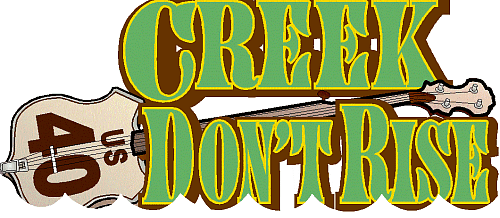



|
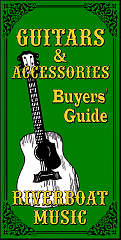
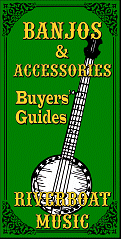
| Written by Paul Race for Creek Don't RiseTM |
| Please Read: How to Help Our Site at No Cost to You - Some of our articles contain recommendations for products we like and vendors we personally trust. Some of those vendors may pay us a very small commission if you click on a link and buy their products. This costs you nothing at all and helps offset the costs of what we do. So if we point you to something you decide to buy later, please make certain you come back through our site and click on the link directly. Thanks. |
| This Site is a Cookie-Free Zone - Except for discussion forums that you have to expressly register for, none of our pages use cookies of any kind. Some of the vendors we link to do, but that won't affect you unless you click on a link to their pages. Your continued use of this page indicates that you agree to our policy. For details, click here. |
19th-Century Guitars
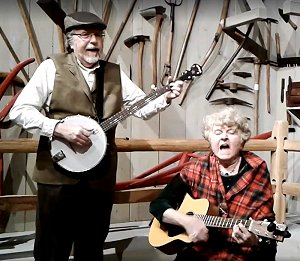 Okay, I occasionally participate in historical reenactments. Very occasionally in the last few years, due to so many of them being canceled. But history is important to me, and I prefer to be accurate when I portray a character from an earlier era. And I prefer to see accuracy when I attend an event that I'm not part of.
Okay, I occasionally participate in historical reenactments. Very occasionally in the last few years, due to so many of them being canceled. But history is important to me, and I prefer to be accurate when I portray a character from an earlier era. And I prefer to see accuracy when I attend an event that I'm not part of.
The photo to the right shows Sister Tess Hoffman and I playing in a reenactment at the Clark County (Ohio) Historical Society in 2017. Representing early 1900s immigrants. Yes, I know Tess' guitar is anachronistic, but I have a better one for her now
Last year, I wrote extensively about "Civil War Banjos," because I was tired of seeing 1920s-era banjos being played by Civil War reenactors, or 1890s-era banjos being sold as "Civil War banjos" when the date of manufacture is clearly stamped on the thing.
Now it's the guitars' turn. I have seen far too many Dreadnoughts (introduced in 1916) or Jumbos (introduced in 1936) being used in Civil War or "Old West" reenactments. (I thought about posting photos as evidence, but most of the folks in the photos are doing their best, so it's probably not fair to single them out.)
Apology to "Serious" Reenactors or Collectors - While researching this article, I came across Steve Ball, a musician who collects and restores 19th century Martins, then uses them in his concerts of authentically-performed Civil War songs. I'm just a Folksinger who knows enough old songs to get by, but who would rather have $150-$400 guitars that look authentic than drag irreplaceable museum pieces over muddy fields, or play them around sooty campfires, or occasionally have to store them in a place (like a tent) that is less than secure.
My concern when it comes to reenactments is to look authentic and to approximate the appropriate style of musical performance, not to nail it perfectly, like Steve does. This may sound like too much of a compromise, but the 19th-century reenactments around here will kick you out for having the wrong shaped heels on your boots and let players with obviously modern guitars and banjos wail out 20th-century Bluegrass hits all day long.
I try to focus on looking and sounding the part, but I have no problem bringing in newer guitars or banjos that look like the priceless antiques they represent. 
Update for 2024 - Video Series - Though I'm keeping this article updated, and it has lots of details and supplementary information, the core information I present here is also presented in a video series that starts here
Spanish Guitars - Before C.F. Martin set up shop in the United States, most guitars in North America were influenced by the "Spanish Guitar," made in one form or another for centuries. By the late 1700s, they had gone from 5 courses of strings (10 strings tuned in pairs) to 6 courses of strings (sort of like modern 12-strings, but with the strings in each course tuned to the same octave.) 
The guitar to the right, made in Cadiz by Joseph Benedid, dates to around 1787. With a few years, Spanish guitars went down to six strings, the same format C.F. Martin used when he designed his first made-in-America guitars.
Civil War Guitars - Though it's probable that Spanish settlers brought the guitar to North America long before 1800, most guitar history among  English-speaking Americans tends to date back to 1833, when C.F. Martin set up shop in the U.S. By the Civil war, he had introduced several models and had several competitors whose guitars tended to reflect his designs.
English-speaking Americans tends to date back to 1833, when C.F. Martin set up shop in the U.S. By the Civil war, he had introduced several models and had several competitors whose guitars tended to reflect his designs.
To be honest, the guitar wasn't as important to Civil War troops as the banjo or fiddle. It wasn't as loud. The "full-sized" guitars of the era were small-bodied by today's standards, and they used gut strings.
There are many stories of banjoists and fiddlers entertaining an entire Union or Confederate regiment. But that didn't seem to happen much, if at all, with guitar - the guitars of the day just weren't loud enough.
Still, there are examples and records of Civil War soldiers taking guitars along on campaigns. So if you are a reenactor, and you want to take your guitar along, that's perfectly fine. But if history's important to you, you should probably consider taking a guitar that at least resembles the guitars of the day.
Ironically, the guitar shown in the photo above right is an unusual shape for the era - the upper bouts tended to be much narrower than the lower bouts, but it does give you an idea of the size of the thing, especially when you remember that the fellow in the photo was likely only about 5'6" tall, the average height of adult males back then.
For another photo from the same era that shows something shaped more like a Martin, click here.
 "Old West" Guitars - Guitars were more popular among cowboys of the Old West. Some people think that's because they were so common among the Spanish-speaking cultures the cowboys frequently encountered. I can't help wonder if it's because they were less likely to spook the cattle than banjo or fiddle. Okay, that part is mostly a joke.
"Old West" Guitars - Guitars were more popular among cowboys of the Old West. Some people think that's because they were so common among the Spanish-speaking cultures the cowboys frequently encountered. I can't help wonder if it's because they were less likely to spook the cattle than banjo or fiddle. Okay, that part is mostly a joke.
By the time the cowboy became a noticeable presence in American popular culture, guitars were already getting bigger. Consequently you often see "singing cowboy" stars dragging around "oversized guitars" like Gibson Jumbos, first marketed in 1936. But during the mid-to-late 1800s when the cowboy was leaving his stamp on American history, the vast majority of guitars were no larger than the guitars of the Civil War.
So if you buy a guitar to use in a Civil War reenactment, and later you want to dress up like a cowboy, you're in luck.
Here's a confession - the unattributed, undated photo to the right purportedly showing a Black Hills guitar player is probably staged. But he is at least holding an appropriately-sized guitar. Unlike the hundreds of supposedly vintage cowboy-with-guitar photos on the Internet showing Jumbos (1936) or Dreadnoughts (1916).
This fellow could be holding a "Size 0" guitar (1854), or a "Size 00" guitar (1874-ish). I can't tell for sure without doing some trigonometry or something to the photo, and, since I'm retired, I don't have to do math any more if I don't want to.
 Why am I comfortable using that as an illustration? Because every photo that can be reliably dated before 1900 shows guitars of this size or smaller.
Why am I comfortable using that as an illustration? Because every photo that can be reliably dated before 1900 shows guitars of this size or smaller.
And that aligns with history. Just about everybody making guitars in the mid-to-late 1800s followed Martin's lead, and Martin didn't introduce any guitars larger than the 00 (sometimes pronounced "double ought") until 1902.
The mustachioed gentlemen to the right could be from as late as the 1890s, yet you still see one man holding a Size 2 or smaller, and the other holding what looks to be a Size one. I've been collecting photos for a while, but they all tell the same story, so I'll leave off inundating you with them for now.
"Parlor" and "Blues" Guitars - This is just here for clarification, because manufacturers and their shills are deliberately confusing 19th-century guitars with student guitars of the early to mid-1900s. They call them all "parlor guitars" and make up stories about how they were introduced in the early 1900s because "standard guitars" were too loud for playing in polite company.
The truth is exactly the opposite. The full-sized guitars of the 1800s were just fine for their intended purposes, but when string bands with banjos and fiddles came along, they couldn't keep up in volume, so companies like Martin and Gibson made progressively larger models, like the Dreadnought, which many people consider the "standard" today.
But those were professional models. Student guitars of the early to mid-1900s tended to keep to Size 00 or 000, And since many of the original Blues players could afford nothing better, those cheap guitars, often characterized by plywood tops, pick guards, tail pieces, 14-fret necks, and (occasionally) sprayed-on "sunbursts" are now celebrated as the ideal Blues guitars.
Ironically, well-made guitars built using 1833, 1854, or 1873 Martin designs are getting classified as "ideal blues guitars" as well.
Just saying - in an effort to sell more instruments, manufacturers and their shills are rewriting history, blurring lines, and inventing overlaps where none exist. So when you google, say, "Civil War guitars," you're likely to see retro designs of cheap mid-1900s student guitars along with the guitars that are actually suitable.
The Original Standard-Sized Guitars
The earliest guitars used in North America reflected the designs being played by Europeans of the time. It's easy to see their resemblances to 18th or early 19-century Spanish guitars, but it might be worth noting that similar guitars were being made in Germany, too. (In fact, C.F. Martin came to the US from a guitar-making family in Germany, though he continually refined his designs once he arrived.)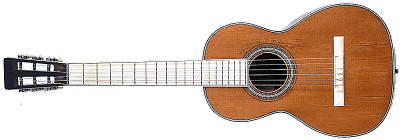 The photo to the right shows a Martin guitar that was made about 1845. It looks like a "Size 1," Martin's most popular guitar for much of the 1800s. And before the Size 0 was invented in 1854, it was the largest guitar Martin made. Many were smaller; in some cases, much smaller.
The photo to the right shows a Martin guitar that was made about 1845. It looks like a "Size 1," Martin's most popular guitar for much of the 1800s. And before the Size 0 was invented in 1854, it was the largest guitar Martin made. Many were smaller; in some cases, much smaller.
In case you think I'm focusing too much on Martin, here are 19th-century guitars from other brands. I'm sure you'll notice the similarities. In fact you'll have trouble finding guitars that look much different.
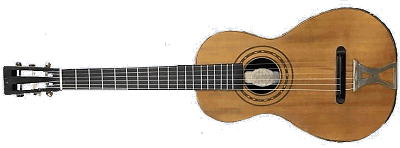 The Tilton guitar to the right has an 1854 patent, though it might be newer by a decade or five. The metal tailpiece could be a much later "add-on" when the owner converted to metal strings. The narrow waist and top bout are reminiscent of a Size 2, but I suspect the lower bout is too wide to be an exact copy.
The Tilton guitar to the right has an 1854 patent, though it might be newer by a decade or five. The metal tailpiece could be a much later "add-on" when the owner converted to metal strings. The narrow waist and top bout are reminiscent of a Size 2, but I suspect the lower bout is too wide to be an exact copy.
 The undated C. Bruno guitar to the right is yet another example of a 'standard-sized' 19th-century guitar. Many guitars in this configuration were made well into the 1930s. The fact this this one has lost the slotted head may imply a later date, or simply a cheaper manufacturing choice.
The undated C. Bruno guitar to the right is yet another example of a 'standard-sized' 19th-century guitar. Many guitars in this configuration were made well into the 1930s. The fact this this one has lost the slotted head may imply a later date, or simply a cheaper manufacturing choice.
For perspective on size, the Size 1 was 12.75" wide at the widest part, while a modern Dreadnought is 15 5/8" inches wide.
The first "bump up" in width of bodies, was led by Martin's Size 0 guitars, first introduced in 1854, with bodies that were 13.5" wide at the widest part. Those were called "concert guitars," because their additional volume allowed them to be heard in larger settings like small concert halls.
Size 0 is considered a sort of turning point in guitar history, and many folks define "Parlor" guitars as anything about that size or smaller.
Size 00 ("Double-Ought") guitars, with bodies 14 1/8" wide were the largest guitars Martin made in the 19th century (and I'm not aware of any other manufacturers making larger ones). These were called "Grand Concert" guitars, because of their greater volume potential. Apparently, they were first advertised about 1874, though earlier specimens have been reported - perhaps they were custom orders.
Today, several manufacturers advertise their "Double-Oughts" as "parlor guitars" and pretend that class of guitar was invented after the Dreadnought (1916). If you are representing any time and place between 1874 and 1900, a "Double-Ought" will serve you fine, especially if it has a 12-fret neck, flat or satin finish, and slotted head. That includes cowboy bunkhouses, Victorian parlors, and Mississippi paddlewheelers.
That said, spite of the larger Type 0 and 00 being available, Size 1 guitars seem to have been the most popular and most imitated guitars right up until the end of the 19th century. '
19th-Century Martin Guitar Profiles
This is just something I found interesting. As Martin increased the size of their guitars, they did it mostly by keeping the same curves and just skootching them outwards. That's why the size 1 and smaller guitars seem to have such a narrow waist compared to their others. The waist and both bouts increased in size almost exactly the same.The drawing below is an approximation, based on photographs of those models, but it gives the general idea.

"Parlor" Guitars for 19th-Century Historical Reenactments
For this part, I'm going back to my original focus - looking for guitars that would be suitable in a 19th-century reenactment - I'm thinking that the most convincing guitars would have the following characteristics.- Slotted peg head (almost always)
- Round "shoulders" (not like the square shoulders of later guitars with 14-fret necks)
- A profile that resembles a Size 2, 1, 0, or 00
- 13.5" wide or narrower up through the Civil War, 14 1/8" or narrower for 1870s on.
- 12 frets between nut and body.
- For best sound unamplified, try to find a solid top.
Unfortunately, very few current guitar models have all of these characteristics, and those that do tend to cost a great deal. Because these models come and go, I won't get into too much detail about specific models. I'll just mention a few examples, many of which are discontinued, but which still turn up from time to time.
Note: In some cases, I'm guessing about the size/model they represent, based on photos in the ads, etc. I don't know why manufacturers are so stingy about simple information like the width of the instrument. But when the difference betwen the widths of these guitars is 3/4" or less, you can't always tell from the photos.
19th-Century Influenced - As of January 2022, mass-produced guitars that could potentially stand in for 19th-century parlor guitars include:
- Size 2-ish - Size 2 guitars are 12" wide at the widest part. As tiny as they look to us today, this and the Size 1 were the "standard" guitars of most of the 19th century. In many settings, Size 2s were played alongside Size 1 and even Size 0 guitars right up until 1900. So a convincing Size 2 guitar would work for any 1800s reenactment in any part of the country.

- The Ibanez PN1 series has a convincing Size 2 shape and an attractive face, but a less-than convincing peg head and a relatively dull sound.
- The Luna Gypsy Parlor (made by Dean) has the same profile and similar issues, in addition to "new agey" markings that you might want to sand off when you're getting rid of that anachronistic glossy finish. It also has a 14-fret neck, which - to my knowledge - never appeared on a 19th-century guitar.
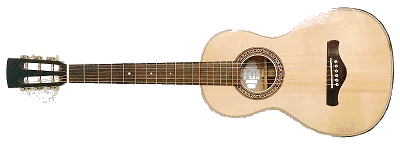 The discontinued - and virtually impossible to find - Ibanez AVN3 maintained the Size 2 profile, but added a solid top and slotted head.
The discontinued - and virtually impossible to find - Ibanez AVN3 maintained the Size 2 profile, but added a solid top and slotted head.
- Size 1-ish - Size 1 guitars were 12 3/4" wide at the widest part. A few Size 1-ish guitars have been made, but most are discontinued, and the ones I can find for under $800, like the discontinued Washburn R314KK, do not have solid tops or consistently good reviews. (The discontinued Washburn R320SWRK has a solid top and better reviews, but when they turn up, they are not cheap enough to risk dragging around most reenactment grounds.)
- Size 0-ish - 13.5" wide. These were relatively expensive instruments when they were introduced in 1854, and they were considered oversized "Concert" instruments, so you probably wouldn't have seen many around Civil War or cowboy campfires. If you don't mind making up a reason your character is dragging an expensive professional instrument through muddy battlefields or cattle drives, you'll be okay, though.
A wealth of 0-inspired guitars are available, some of which have solid tops and slotted heads. They come and go, I'm afraid, so I won't hype any of them too much here, just providing a list worth looking into.
- The Ibanez AVN series "Parlor" guitars mostly seem to have solid tops, but most lack slotted heads (the apparently discontinued AVN5, AVN6, AVN9 and AVN10 series being exceptions). The ones I've seen have something like an 0 profile, so they'd pass in most circumstances.

- The discontinued Washburn WP11SENS had a solid cedar face, slotted head, and fancy inlays that could stand in for 19th-century ornamentation. (It sounds good, too - I have one.)
- The discontinued Breedlove Pursuit Parlor guitar has a solid face and slotted head, though the head shape is funky.
- The Paul Reed Smith SE P20 is a great-sounding 0 lookalike, except for the distinctive PRS peghead which gives it away. And the cost, which keeps me away.
Size 00-ish - 14 1/8" wide. Though a few of this size may have been made before 1874, it doesn't seem like they were commercially available before then. So technically, they would work for the cowboy or late Victorian eras, but they were, frankly too expensive for anyone but professional musicians to own and too big for most folks to imagine dragging around on horseback. So have a convincing explanation why your character spent half a year's wages on the thing and use it anyway, if you want. :-)
- The Ibanez PN 12 and PN15 lines are close to an 00 profile, though they still lack slotted heads or solid tops. Though very few cowboys could afford "double-oughts," twelve-fret 00s did exist from the 1870s on. The sunbursts on some of Ibanez double-oughts is too pronounced for the cowboy era, but that's not unsolvable, especially if affordability is a priority for a guitar you're going to be playing around sooty campfires, etc.
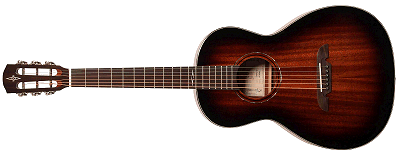
- Alvarez AP66 and AP70 (discontinued) are in the 00 class, have slotted heads and solid tops. The glossy finish gives them away as 21s-century instruments, but that's not insurmountable.
- The Ibanez AC series has a solid top, but it seems to have a profile close to the 14-fret size 00, which would tend to push it into the 1900s.
- The Ibanez AVN series "Parlor" guitars mostly seem to have solid tops, but most lack slotted heads (the apparently discontinued AVN5, AVN6, AVN9 and AVN10 series being exceptions). The ones I've seen have something like an 0 profile, so they'd pass in most circumstances.
Do you notice how the word "discontinued" keeps popping up? Just sayin', if you want a guitar to carry convincingly into a 19th-century reenactment, you'll have to keep your eyes open. As Alice says, they "come and go so quickly."
What About Classical Guitars?
Most classical guitars today are the wrong proportion, although they will fool the average person. The "Spanish"-style guitars that preceded North American guitar manufacture were very narrow by today's standards, so they look "long" to modern eyes. Actually, they're just relatively skinny. 11" lower bouts seem to be common, in comparison to the Martin Size 2s, which have a 12" bout and look tiny today.
As an example, Barcelona builder Jose Massague built this guitar in the mid-18th century. Its shape is echoed by the vast majority of 'Spanish' guitars made before 1850, though they had almost all gone to six strings by then.
As "American" guitars (meaning mostly Martin and their imitators) grew wider during the 1800s, so did the Spanish-style guitar, but their growth followed different proportions. Today, people confuse "Spanish guitars" with "Classical Guitars." I've even seen references that claim they are the same instrument, just played differently. Fine. But you will likely have trouble finding a "classical guitar" that has the same proportions as mid-19th-century "Spanish guitars" or "American guitars."
The ones that come closest are a few mid-20th-century student "classicals" that used the Size 0 or 00 bodies that brands like Harmony or Silvertone were using for their steel-stringed instruments. Look for an overall length of about 39", a body length of about 19" and a width of a maximum 13.5" (12.75" would be better.)
The vast majority of "student" classicals being made today are too short in the body. They look like "baby guitars" because they are.
Not to mention that steel strings will do damage to any solid-body classicals you come across, and many of the veneer instruments.
Shopping Aid?
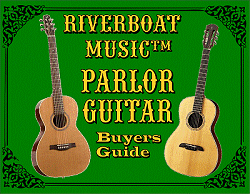 I've deliberately kept vendor links out of this article, because A: they're so hard to keep updated as vendors pick up and drop product lines and B: so many of the products I've discuss are already discontinued and hard to find.
I've deliberately kept vendor links out of this article, because A: they're so hard to keep updated as vendors pick up and drop product lines and B: so many of the products I've discuss are already discontinued and hard to find.
However, if this article has whetted your appetite for archaic-looking guitars, we have listed most of the low- to medium-priced instruments that we can find in these categories in our Riverboat Music "Parlor Guitars Buyer's Guide."
Conclusion
As I researched this article, I found myself including more and more content that didn't exactly align with my stated purpose, but might be of interest to anyone else researching these things. I also have a sort of confession. Some time back I found a lightly used Ibanez PN1MH-NT. I admit I was attracted both to its vintage shape and to its very low (used) price. If I'd been buying a new one, I'd have held out for the "OPN" ("open pore") version, which doesn't have the shiny face.
I also have a sort of confession. Some time back I found a lightly used Ibanez PN1MH-NT. I admit I was attracted both to its vintage shape and to its very low (used) price. If I'd been buying a new one, I'd have held out for the "OPN" ("open pore") version, which doesn't have the shiny face.
Ibanez claims it's based on the Size 2, which is a tiny bit smaller than the Size 1 Martin, but the look is very similar.
It's not set up yet, since I plan to do some tweaking to make it look more like a vintage guitar, including sanding the face and the front of the peg head to get rid of the shine and the Ibanez logo. (If I'd bought the OPN version I wouldn't have to sand the face.)
The mahogany veneer face of this instrument (and the Luna Gypsy Parlor mahogany version) looks more authentic to me than the pretty pale spruce face of the Ibanez PN1NT version, which is also too shiny for my taste. So this was a compromise, but one I may be able to make work nicely if the reenactments I used to do ever start up again. And at this price, I won't mind dragging it onto some muddy park grounds, or the like.
In the meantime, I have to confess that it doesn't have great tone, and I doubt it will every handle low notes as well as bigger guitars. But even laminate guitars can improve in tone over the years, so I'm not giving up hope just yet. I'll keep you posted.
 Update for February, 2022 Okay, here's another confession. While trying to find an Ibanez AP66 or (discontinued) AP70 at a good price, I stumbled across a used (discontinued) Washburn WP11SNS. It is a size 0 with a solid cedar top. It's easily twice as loud, and fuller-sounding than the Ibanez PN1MH,
Update for February, 2022 Okay, here's another confession. While trying to find an Ibanez AP66 or (discontinued) AP70 at a good price, I stumbled across a used (discontinued) Washburn WP11SNS. It is a size 0 with a solid cedar top. It's easily twice as loud, and fuller-sounding than the Ibanez PN1MH,
That said, I'm keeping the "peanut" (Ibanez PN1MH), with the goal of reconfiguring it slightly in case I participate in an outdoor recreation where I can't guarantee the safety of a better guitar.
Finally, I confess that a number of "reenactments" I play aren't all THAT picky, and there have been times I wish my bass player had something to play that visually matched the rest of our instruments (so we can sneak her in).
 So I ordered an Ibanez PNB14E, which has a Size 0 body and neck, but is strung like a bass. Not a LOT of volume, bass tone, or - frankly - quality control, but worth troubleshooting and setting up. If the bass-style tuning pegs cause objections, they can be replaced with something more "period-looking."
So I ordered an Ibanez PNB14E, which has a Size 0 body and neck, but is strung like a bass. Not a LOT of volume, bass tone, or - frankly - quality control, but worth troubleshooting and setting up. If the bass-style tuning pegs cause objections, they can be replaced with something more "period-looking."
That said, if you get one of these, check it out immediately. I have bought three, and two had problems that are beyond the average non-repairman's ability to fix.
Best of luck to you all, and please let me know if you have any questions or corrections.
And please stay in touch!
All material, illustrations, and content of this web site is copyrighted ? 2001, 2002, 2003, 2004, 2005, 2006,
For questions, comments, suggestions, trouble reports, etc. about this page or this site, please
contact us.
And that, in turn, helps us provide more useful resources. Thank you!
 Whatever else you get out of our pages, I hope you come away with some great ideas for "sharing the joy."
Whatever else you get out of our pages, I hope you come away with some great ideas for "sharing the joy."
2007, 2008, 2009, 2010, 2011, 2012, 2013, 2014, 2015, 2016, 2017, 2018, 2019, 2020, 2021, 2022 by Paul D. Race. All rights reserved.
Creek Dont' Rise(tm) is a participant in the Amazon Services LLC Associates Program, an affiliate advertising
program designed to provide a means for sites to earn advertising fees by advertising and linking to Amazon.com.
How To Help Us Promote Traditional Music for Free: If you find our tips, explanations, and recommendations helpful when picking out a product, and you appreciate that we don't continually inconvenience you with irrelevant ads or obnoxious popups, Please Bookmark This Page and come back through it when you're ready to order. In some cases - not all - we get a very small portion of your purchase price, all of which goes to supporting our sites. Ironically, if you don't come through our page, someone else like Facebook or the Weather Channel will usually get that "fee" anyway. In the meantime, it costs you nothing. We never see who placed the order, so you don't have to worry about us pestering you with followup e-mails or some such. But it helps us know what pages our readers find useful, and it helps our advertisers know who to support.
| Visit related pages and affiliated sites: | |||||
| - Music - | |||||

|
 |
 |

|

|

|

|

|

|

|

|

|

|

|

|

|

|

|
| - Trains and Hobbies - | |||||
 |

|

|  |
 |

|
| - Christmas Memories and Collectibles - | |||||
 |

|
 |

|
 |

|
| - Family Activities and Crafts - | |||||
 |

|

|

|

|

|

